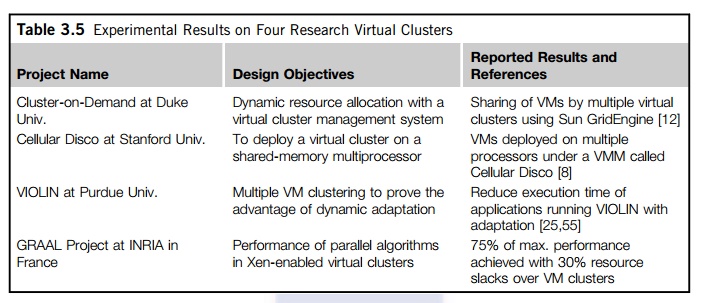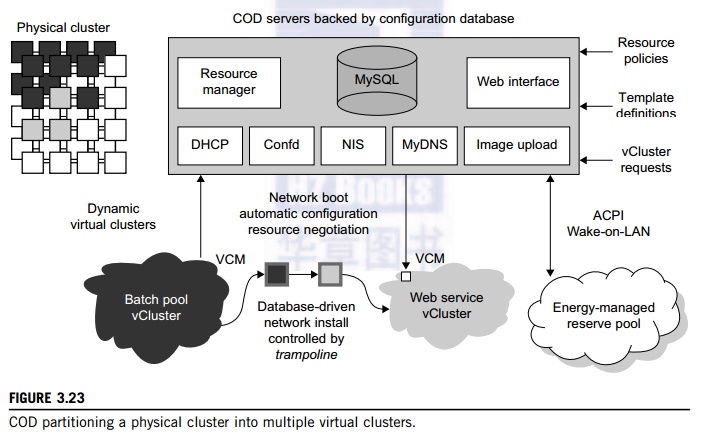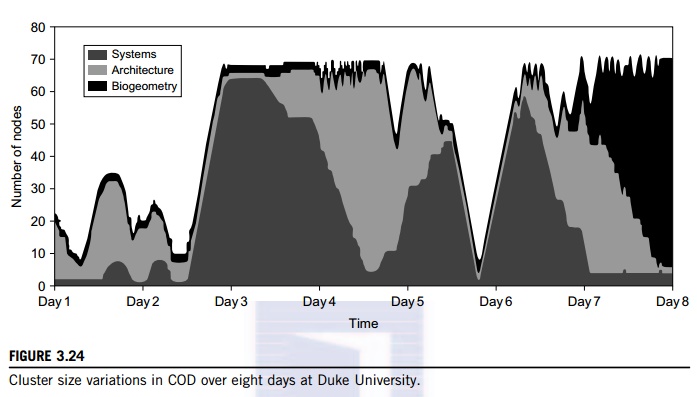Chapter: Distributed and Cloud Computing: From Parallel Processing to the Internet of Things : Virtual Machines and Virtualization of Clusters and Data Centers
Dynamic Deployment of Virtual Clusters
Dynamic Deployment of Virtual Clusters
Table 3.5 summarizes four virtual cluster research projects. We briefly introduce them here just to identify their design objectives and reported results. The Cellular Disco at Stanford is a virtual cluster built in a shared-memory multiprocessor system. The INRIA virtual cluster was built to test parallel algorithm performance. The COD and VIOLIN clusters are studied in forthcoming examples.


Example 3.9 The Cluster-on-Demand (COD) Project at Duke University
Developed by researchers at Duke University, the COD (Cluster-on-Demand) project is a virtual cluster management system for dynamic allocation of servers from a computing pool to multiple virtual clusters [12]. The idea is illustrated by the prototype implementation of the COD shown in Figure 3.23. The COD

partitions a physical cluster into multiple virtual clusters (vClusters). vCluster owners specify the operating systems and software for their clusters through an XML-RPC interface. The vClusters run a batch schedule from Sun’s GridEngine on a web server cluster. The COD system can respond to load changes in restruc-turing the virtual clusters dynamically.
The Duke researchers used the Sun GridEngine scheduler to demonstrate that dynamic virtual clusters are an enabling abstraction for advanced resource management in computing utilities such as grids. The system supports dynamic, policy-based cluster sharing between local users and hosted grid services. Attractive features include resource reservation, adaptive provisioning, scavenging of idle resources, and dynamic instantiation of grid services. The COD servers are backed by a configuration database. This system provides resource policies and template definition in response to user requests.
Figure 3.24 shows the variation in the number of nodes in each of three virtual clusters during eight days of a live deployment. Three application workloads requested by three user groups are labeled “Systems,” “Architecture,” and “BioGeometry” in the trace plot. The experiments were performed with multiple SGE batch pools on a test bed of 80 rack-mounted IBM xSeries-335 servers within the Duke cluster. This trace plot clearly shows the sharp variation in cluster size (number of nodes) over the eight days. Dynamic provisioning and deprovisioning of virtual clusters are needed in real-life cluster applications.
Example 3.10 The VIOLIN Project at Purdue University
The Purdue VIOLIN Project applies live VM migration to reconfigure a virtual cluster environment. Its purpose is to achieve better resource utilization in executing multiple cluster jobs on multiple cluster domains. The project leverages the maturity of VM migration and environment adaptation technology. The approach is to enable mutually isolated virtual environments for executing parallel applications on top of a shared physical infrastructure consisting of multiple domains. Figure 3.25 illustrates the idea with five concurrent virtual environments, labeled as VIOLIN 1–5, sharing two physical clusters.
The squares of various shadings represent the VMs deployed in the physical server nodes. The major contribution by the Purdue group is to achieve autonomic adaptation of the virtual computation environments as active, integrated entities. A virtual execution environment is able to relocate itself across the infrastructure, and can scale its share of infrastructural resources. The adaptation is transparent to both users of virtual environments and administrations of infrastructures. The adaptation overhead is maintained at 20 sec out of 1,200 sec in solving a large NEMO3D problem of 1 million particles.
The message being conveyed here is that the virtual environment adaptation can enhance resource utilization significantly at the expense of less than 1 percent of an increase in total execution time. The

migration of VIOLIN environments does pay off. Of course, the gain in shared resource utilization will bene-fit many users, and the performance gain varies with different adaptation scenarios. We leave readers to trace the execution of another scenario in Problem 3.17 at the end of this chapter to tell the differences. Virtual networking is a fundamental component of the VIOLIN system.
Related Topics